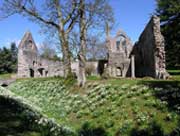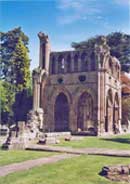Dryburgh Abbey
 Dryburgh Abbey lies a few hundred yards north of the village of St Boswells. Yet its location, surrounded on three sides by a loop in the River Tweed, means that by road the journey is one of several miles.
Dryburgh Abbey lies a few hundred yards north of the village of St Boswells. Yet its location, surrounded on three sides by a loop in the River Tweed, means that by road the journey is one of several miles.
Founded by High de Moreville who was the main landowner in the area. His family had come across from Normandy with William the Conqueror, and he himself had befriended David I of Scotland, eventually becoming Constable of Scotland. He took a more personal role in his own salvation, than most of his contempories by becoming a novice at Dryburgh in his old age and dying there in 1162. He should not be confused with his son, also called Hugh, who helped murder Archbishop Thomas Becket in Canterbury Cathedral in 1170.
The monks who settled at Dryburgh Abbey were Premonstratensians, from Alnwick Abbey in Northumberland. It is thought that work began on the abbey in 1150, and probably continued for most of the following century.
 Dryburgh's location meant it inevitably became caught up in the wars between England and Scotland. In 1322 it is said that Edward II's army, retreating south to England, took exception to the sound of the bells of Dryburgh Abbey being rung to celebrate their defeat. They burned it down.
Dryburgh's location meant it inevitably became caught up in the wars between England and Scotland. In 1322 it is said that Edward II's army, retreating south to England, took exception to the sound of the bells of Dryburgh Abbey being rung to celebrate their defeat. They burned it down.
What emerged from a rebuilding process that probably took another 100 years was even bigger and better than before, despite further destruction by another English army in 1385. But the completed abbey of the 1400s would only see a further century of active use. The end effectively came on 4 November 1544 when some 700 English troops mounted a raid across the border, destroying both Dryburgh Abbey and the nearby town.
 The second main attraction of Dryburgh is that so much of the domestic architecture remains visible. In a reversal of what has happened in other abbeys like nearby Melrose and Jedburgh. It is possible to gain a sense of the day to day lives of the monks, while the Abbey Church itself has largely disappeared.
The second main attraction of Dryburgh is that so much of the domestic architecture remains visible. In a reversal of what has happened in other abbeys like nearby Melrose and Jedburgh. It is possible to gain a sense of the day to day lives of the monks, while the Abbey Church itself has largely disappeared.
Here you find the chapels in and around which are buried Sir Walter Scott and Field Marshal Haig amongst others.
The remains of the abbey were aquired by the Earl of Buchan in 1786. He created within and around it a large formal garden and built an obelisk to its founder.
